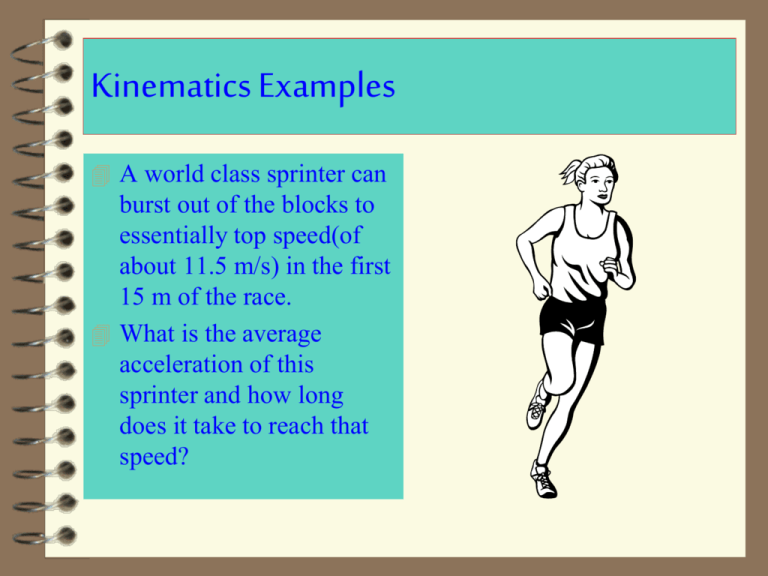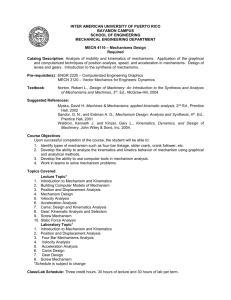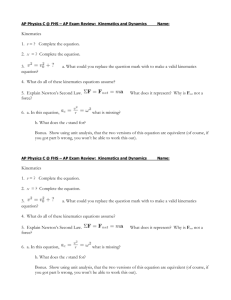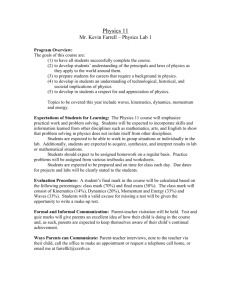Kinematics Examples: Sprinter & Car Physics Problems
advertisement

Kinematics Examples A world class sprinter can burst out of the blocks to essentially top speed(of about 11.5 m/s) in the first 15 m of the race. What is the average acceleration of this sprinter and how long does it take to reach that speed? Kinematics Examples Read and Reread Draw Diagram w/axes List quantities (known/unknown) Physics Principle Find an equation Estimate a reasonable answer Calculate and decide if reasonable Kinematics Examples Let's say you're driving in your car, approaching a red light on Delaware Avenue. A black Porsche is stopped at the light in the right lane, but there's noone in the left lane, so you pull into the left lane. You're traveling at 40 km/hr, and when you're 15 meters from the stop line the light turns green. You sail through the green light at a constant speed of 40 km/hr and pass the Porsche, which accelerated from rest at a constant rate of 3 m/s2 starting at the moment the light turned green. Kinematics Examples (a) How far from the stop line do you pass the Porsche? (b) When does the Porsche pass you? (c) If a police officer happens to get you and the Porsche on the radar gun at the instant the Porsche passes you, will either of you be pulled over for speeding? Assume the speed limit is 50 km/hr. Kinematics Examples Origin = stop line Positive direction = the direction you're traveling Kinematics Examples Kinematics Examples Step 2 - Figure out what you need to solve for. At the instant you pass the Porsche, the x values (yours and the Porsche's) have to be equal. You're both the same distance from the stop line, in other words. Write out the expression for your x-value and the Porsche's. Kinematics Examples We'll use the equation: x = xo + vot + 1/2 at2 For you : x = -15 + 11.11 t + 0 For the Porsche : x = 0 + 0 + 1/2 (3) t2 = 1.5 t2 Kinematics Examples At some time t, when you pass the Porsche, these x values will be the same. So, we can set the equations equal to one another and solve for time, and then plug the time back in to either x equation to get the distance from the stop line. Doing this gives: -15 + 11.11 t = 1.5 t2 Kinematics Examples Bringing everything to one side gives: 1.5 t2 - 11.11 t + 15 = 0 This is a quadratic equation, which we can solve using the quadratic formula: Kinematics Examples where a = 1.5, b = -11.11, and c = 15 This gives two values for t, t = 1.776 s and t = 5.631 s. Kinematics Examples What do these two values mean? In many cases only one answer will be relevant, and you'll have to figure out which. In this case both are relevant. The smaller value is when you pass the Porsche, while the larger one is when the Porsche passes you back. Kinematics Examples To get the answer to question (a), plug t = 1.776 into either of your x expressions. They should both give you the same value for x, so you can use one as a check Kinematics Examples For you, at t = 1.776, x = 4.73 m. For the Porsche, at t = 1.776 s, x = 4.73 m. We've actually already calculated the answer to (b), when the Porsche passes you, which is at t = 5.6 s. Kinematics Examples To get the answer to part (c), we already know that you're traveling at a constant speed of 40 km/hr, which is under the speed limit. To figure out how fast the Porsche is going at t = 5.631 seconds, use: v = vo + a t = 0 + (3) (5.631) = 16.893 m/s. Kinematics Examples Converting this to km/hr gives a speed of 60.8 km/hr, so the driver of the Porsche is in danger of getting a speeding ticket.






